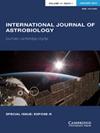DNA修复途径在暴露于高LET辐射的干燥、抗辐射蓝细菌恢复中的作用:对火星宜居性的影响
IF 1
4区 物理与天体物理
Q3 ASTRONOMY & ASTROPHYSICS
引用次数: 4
摘要
摘要如果火星上曾经出现过生命,并且当表面条件变得过于恶劣时,它确实躲到了亚表层环境中,那么它应该定期从冻结的休眠状态中复活,以修复累积的损伤,并在下一个休眠阶段将生存时钟重置为零。因此,揭示地球休眠微生物能在多长时间内应对模拟长期辐射的高LET辐射,对于深入了解火星地下休眠微生物生命在地质时间尺度上的长期弹性至关重要,因为地质时间尺度可能利用了周期性的温和条件,从而修复了累积的DNA损伤。抗辐射蓝细菌Chroocccidiopsis sp.CCMEE 029的干细胞暴露于2kGy的重离子辐射(Fe离子)并没有显著降低其存活率,尽管DNA损伤已经积累。再水合后,DNA损伤得到修复,如参与修复双链断裂(DSBs)、氧化碱基和无嘌呤无嘧啶位点的基因过度表达所示。事实上,复水后对修复基因的监测表明RecF同源重组在修复DSBs中起着关键作用。在BER系统的八个基因中,只有一个基因上调,这表明不存在通常由紫外线辐射诱导的DNA损伤。总之,暴露在2kGy铁离子辐射下的干燥Chroocccidiopsis的存活率没有显著降低,这进一步扩大了我们对火星地下假定休眠生命的恢复力的认识。此外,在寻找木卫二和土卫二上的生命时,这一点也很重要,因为那里的辐射环境可能会严重影响休眠、冷冻生命形式的长期生存。本文章由计算机程序翻译,如有差异,请以英文原文为准。
Role of DNA repair pathways in the recovery of a dried, radioresistant cyanobacterium exposed to high-LET radiation: implications for the habitability of Mars
Abstract If life ever appeared on Mars and if it did refuge into sub-superficial environments when surface conditions turned too hostile, then it should have been periodically revived from the frozen, dormant state in order to repair the accumulated damage and reset the survival clock to zero for the next dormant phase. Thus, unravelling how long Earth dormant microorganisms can cope with high-LET radiation mimicking long-term irradiation is fundamental to get insights into the long-term resilience of a dormant microbial life in the Martian subsurface over geological timescales that might have taken advantage of periodically clement conditions that allowed the repair of the accumulated DNA damage. The exposure of dried cells of the radioresistant cyanobacterium Chroococcidiopsis sp. CCMEE 029 to 2 kGy of heavy-ion radiation (Fe ions) did not significantly reduce its survival, although DNA damage was accumulated. Upon rehydration, DNA lesions were repaired as suggested by the over-expression of genes involved in the repair of double strand breaks (DSBs), oxidized bases and apurinic-apyrimidinic sites. Indeed, the monitoring of repair genes upon rehydration suggested a key role of the RecF homologous recombination in repairing DSBs. While the fact that out of the eight genes of the BER system, only one was up-regulated, suggested the absence of DNA lesions generally induced by UV radiation. In conclusion, the non-significantly reduced survival of dried Chroococcidiopsis exposed to 2 kGy of Fe-ion radiation further expanded our appreciation of the resilience of a putative dormant life in the Martian subsurface. Moreover, it is also relevant when searching life on Europa and Enceladus where the radiation environment might critically affect the long-term survival of dormant, frozen life forms.
求助全文
通过发布文献求助,成功后即可免费获取论文全文。
去求助
来源期刊

International Journal of Astrobiology
地学天文-地球科学综合
CiteScore
3.70
自引率
11.80%
发文量
45
审稿时长
>12 weeks
期刊介绍:
International Journal of Astrobiology is the peer-reviewed forum for practitioners in this exciting interdisciplinary field. Coverage includes cosmic prebiotic chemistry, planetary evolution, the search for planetary systems and habitable zones, extremophile biology and experimental simulation of extraterrestrial environments, Mars as an abode of life, life detection in our solar system and beyond, the search for extraterrestrial intelligence, the history of the science of astrobiology, as well as societal and educational aspects of astrobiology. Occasionally an issue of the journal is devoted to the keynote plenary research papers from an international meeting. A notable feature of the journal is the global distribution of its authors.
 求助内容:
求助内容: 应助结果提醒方式:
应助结果提醒方式:


